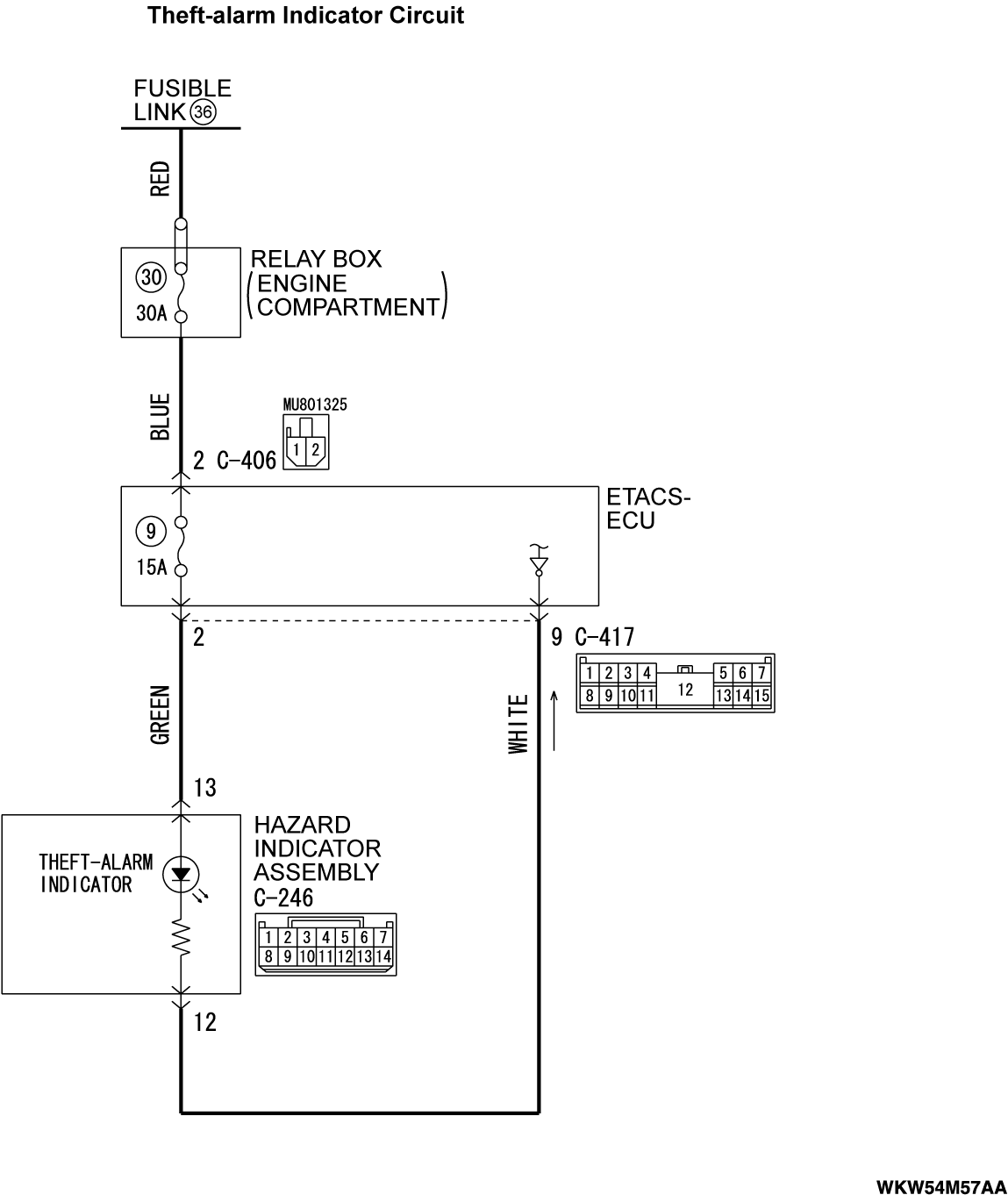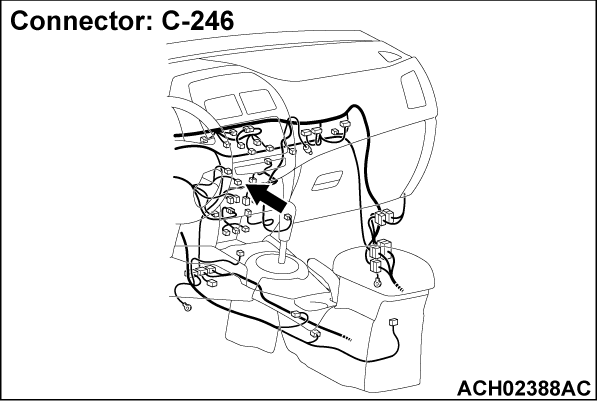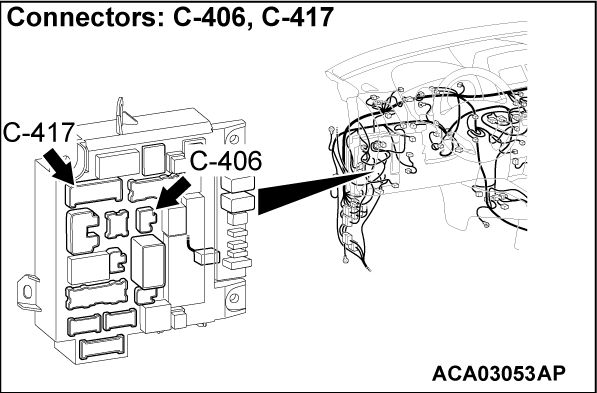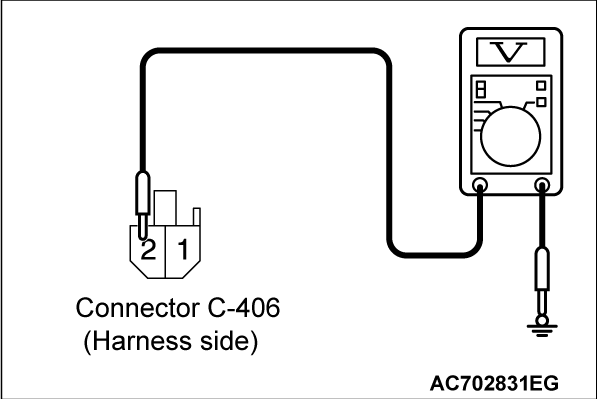Inspection Procedure 1: The theft-alarm is not armed (the theft-alarm indicator does not illuminate).
| caution | Before replacing the ECU, ensure that the power supply circuit, the ground circuit and the communication circuit are normal. |
TECHNICAL DESCRIPTION (COMMENT)
If this function does not work normally, the input signal circuits to the components below, the theft-alarm indicator, the ETACS-ECU or the CAN bus line may have a problem.
- Keyless entry transmitter
- Key reminder switch
- Ignition switch (ACC)
- Hood latch switch
- Door switches
- Liftgate latch switch
TROUBLESHOOTING HINTS
- CAN bus line may be defective
- Theft-alarm indicator may be defective
- Keyless entry transmitter may be defective
- The key reminder switch may be defective
- Door switch may be defective
- Liftgate latch switch may be defective
- Hood latch switch may be defective
- The KOS-ECU may be defective
- The WCM may be defective
- The ETACS-ECU may be defective
- The wiring harness or connectors may have loose, corroded, or damaged terminals, or terminals pushed back in the connector
DIAGNOSIS
Required Special Tools:
- MB991223: Harness Set
- MB992006: Extra Fine Probe
STEP 1. Using scan tool MB991958, diagnose the CAN bus line.
(1)
| caution | To prevent damage to scan tool MB991958, always turn the ignition switch to the "LOCK" (OFF) position before connecting or disconnecting scan tool MB991958. |
(2) Turn the ignition switch to the "ON" position.
(3) Diagnose the CAN bus line.
(4) Turn the ignition switch to the "LOCK" (OFF) position.
Is the CAN bus line found to be normal?
STEP 2. Using scan tool MB991958, check for any diagnostic trouble code.
Check if DTC is set in the KOS-ECU <vehicles with KOS> or WCM <vehicles with WCM>.
(1) Turn the ignition switch to the "ON" position.
(2) Check whether the KOS or WCM related DTC is set.
(3) Turn the ignition switch to the "LOCK" (OFF) position.
Is the DTC set?
STEP 3. Check the keyless operation key <KOS> or keyless entry transmitter <WCM>.
is the keyless operation key <KOS> or keyless entry transmitter <WCM> normally?
STEP 4. Using scan tool MB991958, check data list.
Use the ETACS-ECU data list to check the signals related to the theft-alarm function.
 <Normal condition is not displayed for item No. 256.> : Troubleshoot the ETACS-ECU. Refer to Inspection Procedure 5 "ETACS-ECU does not receive any signal from the front door switch (LH)"
<Normal condition is not displayed for item No. 256.> : Troubleshoot the ETACS-ECU. Refer to Inspection Procedure 5 "ETACS-ECU does not receive any signal from the front door switch (LH)"  .
. <Normal condition is not displayed for item No. 257.> : Troubleshoot the ETACS-ECU. Refer to Inspection Procedure 6 "ETACS-ECU does not receive any signal from the front door switch (RH)"
<Normal condition is not displayed for item No. 257.> : Troubleshoot the ETACS-ECU. Refer to Inspection Procedure 6 "ETACS-ECU does not receive any signal from the front door switch (RH)"  .
. <Normal condition is not displayed for item No. 258.> : Troubleshoot the ETACS-ECU. Refer to Inspection Procedure 7 "ETACS-ECU does not receive any signal from the rear door switch (LH)"
<Normal condition is not displayed for item No. 258.> : Troubleshoot the ETACS-ECU. Refer to Inspection Procedure 7 "ETACS-ECU does not receive any signal from the rear door switch (LH)"  .
. <Normal condition is not displayed for item No. 259.> : Troubleshoot the ETACS-ECU. Refer to Inspection Procedure 8 "ETACS-ECU does not receive any signal from the rear door switch (RH)"
<Normal condition is not displayed for item No. 259.> : Troubleshoot the ETACS-ECU. Refer to Inspection Procedure 8 "ETACS-ECU does not receive any signal from the rear door switch (RH)"  .
. <Normal condition is not displayed for item No. 260.> : Troubleshoot the ETACS-ECU. Refer to Inspection Procedure 9 "ETACS-ECU does not receive any signal from liftgate latch switch"
<Normal condition is not displayed for item No. 260.> : Troubleshoot the ETACS-ECU. Refer to Inspection Procedure 9 "ETACS-ECU does not receive any signal from liftgate latch switch"  .
. <Normal condition is not displayed for item No. 264.> : Troubleshoot the ETACS-ECU. Refer to Inspection Procedure 3 "ETACS-ECU does not receive any signal from key reminder switch"
<Normal condition is not displayed for item No. 264.> : Troubleshoot the ETACS-ECU. Refer to Inspection Procedure 3 "ETACS-ECU does not receive any signal from key reminder switch"  .
.
- Turn the ignition switch to the "ACC" position.
|
- Turn the ignition switch to the "LOCK" (OFF) position (with ignition key <vehicles with WCM> or emergency key <vehicles with KOS> inserted).
|
- Open each door.
- Open the liftgate.
- Open the hood.
|
- Close each door.
- Close the liftgate.
- Open the hood.
|
Does scan tool MB991958 display the items "Dr door ajar switch", "As door ajar switch", "RR door ajar switch", "RL door ajar switch", "Trunk/gate trunk ajar switch" , "Handle lock switch", "Hood switch" and "ACC switch" as normal condition?
 <Normal condition is not displayed for item No. 256.> : Troubleshoot the ETACS-ECU. Refer to Inspection Procedure 5 "ETACS-ECU does not receive any signal from the front door switch (LH)"
<Normal condition is not displayed for item No. 256.> : Troubleshoot the ETACS-ECU. Refer to Inspection Procedure 5 "ETACS-ECU does not receive any signal from the front door switch (LH)"  .
. <Normal condition is not displayed for item No. 257.> : Troubleshoot the ETACS-ECU. Refer to Inspection Procedure 6 "ETACS-ECU does not receive any signal from the front door switch (RH)"
<Normal condition is not displayed for item No. 257.> : Troubleshoot the ETACS-ECU. Refer to Inspection Procedure 6 "ETACS-ECU does not receive any signal from the front door switch (RH)"  .
. <Normal condition is not displayed for item No. 258.> : Troubleshoot the ETACS-ECU. Refer to Inspection Procedure 7 "ETACS-ECU does not receive any signal from the rear door switch (LH)"
<Normal condition is not displayed for item No. 258.> : Troubleshoot the ETACS-ECU. Refer to Inspection Procedure 7 "ETACS-ECU does not receive any signal from the rear door switch (LH)"  .
. <Normal condition is not displayed for item No. 259.> : Troubleshoot the ETACS-ECU. Refer to Inspection Procedure 8 "ETACS-ECU does not receive any signal from the rear door switch (RH)"
<Normal condition is not displayed for item No. 259.> : Troubleshoot the ETACS-ECU. Refer to Inspection Procedure 8 "ETACS-ECU does not receive any signal from the rear door switch (RH)"  .
. <Normal condition is not displayed for item No. 260.> : Troubleshoot the ETACS-ECU. Refer to Inspection Procedure 9 "ETACS-ECU does not receive any signal from liftgate latch switch"
<Normal condition is not displayed for item No. 260.> : Troubleshoot the ETACS-ECU. Refer to Inspection Procedure 9 "ETACS-ECU does not receive any signal from liftgate latch switch"  .
. <Normal condition is not displayed for item No. 264.> : Troubleshoot the ETACS-ECU. Refer to Inspection Procedure 3 "ETACS-ECU does not receive any signal from key reminder switch"
<Normal condition is not displayed for item No. 264.> : Troubleshoot the ETACS-ECU. Refer to Inspection Procedure 3 "ETACS-ECU does not receive any signal from key reminder switch"  .
.STEP 5. Check hazard indicator assembly connector C-246 for loose, corroded or damaged terminals, or terminals pushed back in the connector.
Is hazard indicator assembly connector C-246 in good condition?
 Repair the damaged parts.
Repair the damaged parts.STEP 6. Check the theft-alarm indicator.
STEP 7. Check ETACS-ECU connector C-406 for loose, corroded or damaged terminals, or terminals pushed back in the connector.
STEP 8. Measure the voltage at ETACS-ECU connector C-406.
(1) Disconnect ETACS-ECU connector C-406, and measure the voltage wiring harness side.
(2) Measure the voltage between ETACS-ECU connector C-406 (terminal No. 2) and the body ground.
- The voltage should measure approximately 12 volts (battery positive voltage).
Is the measured voltage approximately 12 volts (battery positive voltage)?
STEP 9. Check the Wiring harness between ETACS-ECU connector C-406 (terminal No. 2) and fusible link (36).
- Check the power supply line for open circuit and short circuit.
Is the check result normal?
 The trouble can be an intermittent malfunction (Refer to GROUP 00, How to use Troubleshooting/inspection Service Points - How to Cope with Intermittent Malfunction
The trouble can be an intermittent malfunction (Refer to GROUP 00, How to use Troubleshooting/inspection Service Points - How to Cope with Intermittent Malfunction  ).
). Repair the wiring harness between ETACS-ECU connector C-406 and fusible link (36).
Repair the wiring harness between ETACS-ECU connector C-406 and fusible link (36).STEP 10. Check ETACS-ECU connector C-417 for loose, corroded or damaged terminals, or terminals pushed back in the connector.
STEP 11. Check the Wiring harness between ETACS-ECU connector C-417 (terminal No. 2,9) and hazard indicator assembly connector C-246 (terminal No. 13,12).
- Check the input/output lines for open circuit and short circuit.
Is the check result normal?
 Repair the wiring harness between ETACS-ECU connector C-417 and hazard indicator assembly connector C-246.
Repair the wiring harness between ETACS-ECU connector C-417 and hazard indicator assembly connector C-246.![[Previous]](../../../buttons/fprev.png)
![[Next]](../../../buttons/fnext.png)



